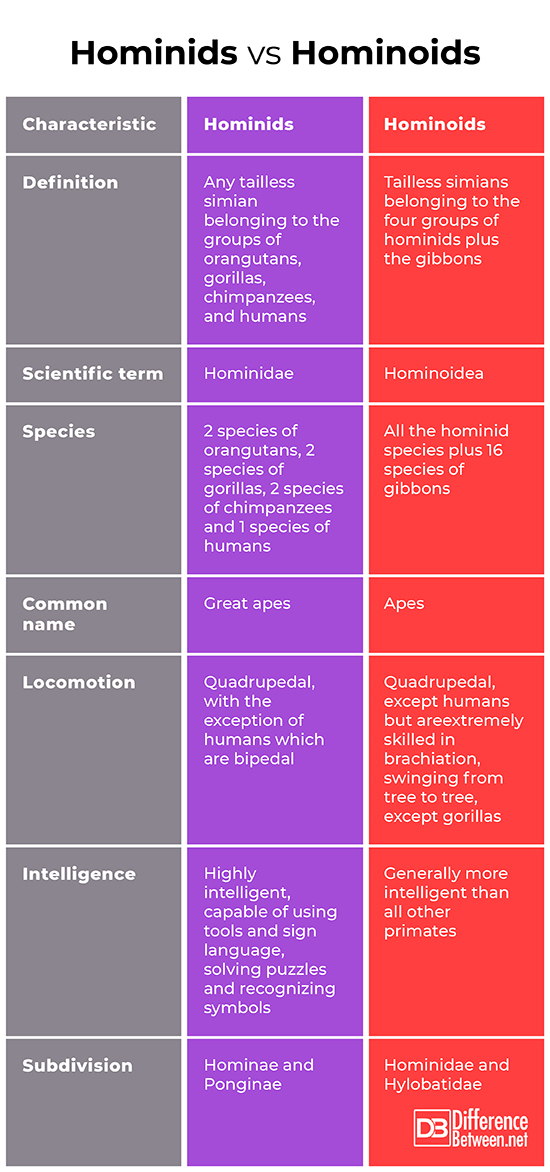Difference Between Hominids and Hominoids
Hominids and hominoids are two different but related classifications of primate taxonomy. They are tailless and simian, meaning they look and are related to monkeys in a more general classification. Both are broad terms that refer to species both living and extinct. In taxonomy, both hominids and hominoids are considered families, classified, in descending order, as under the Kingdom Animalia, Phylum Chordata, Class Mammalia, and Order Primates. In taxonomy, they are generally called apes. Humans are included in these two families, but the term ape does not include humans in common parlance.
The main difference between the two is the species included within each one. The hominid is a lesser classification while the hominoid is a larger classification. More about hominids and hominoids and their differences are discussed in the following.
What are Hominids?
Hominids are any primates that belong to the family commonly known as the great apes. The scientific term is Hominidae. This is the family under which humans are more specifically classified, along with orangutans, gorillas, and chimpanzees. The term hominid was originally the collective term for the family of humans only, including their extinct ancestors and relatives like the Neanderthal and the Australopithecus. The orangutans, gorillas, and chimpanzees used to be classified separately under the family Pongidae. However, after genetic studies showed that chimpanzees resemble humans more closely than they do orangutans, taxonomists decided to include all four under the same family Hominidae. This group is further divided into two; Homininae, the humans, chimpanzees and gorillas, and Ponginae with only the orangutans belonging in this latter group. Currently, there are 2 surviving species of orangutans, 2 species of gorillas, 2 species of chimpanzees and the one species of humans.
In the study of evolution, the hominids are said to have split from the other apes starting with the orangutans about 14 million years ago, followed by the gorillas about million years ago, with the most recent split between chimpanzees and humans around 5 million years ago.
They are called the great apes because they are generally larger than other apes. But hominids are distinct from other apes, not only for their size but also for their high intelligence, even when excluding humans from the group. Many researches have shown that orangutans, gorillas, and chimpanzees are capable of using tools and recognizing symbols, use sign language and solve puzzles.
What are Hominoids?
Hominoids are any of the primates all collectively known as apes. The scientific term is Hominoidea. This is a superfamily that has two subfamilies. One is the family Hominidae which has already been discussed. The other is Hylobatidae, the hylobatids, also known as the lesser apes. The hylobatids have a total of 16 different species although they are all commonly called as gibbons and are all native to Asia.
Although mostly quadrupedal, moving on all four limbs with the exception of the humans and their extinct relatives, and the gorillas which are the biggest of the apes, hominoids are skilled tree climbers and are very agile once they are in the trees. Hominoids have a lower center of gravity, a short spine relative to their body length, a broad pelvis, and wide chest. This general body build allows them a more upright posture than other primates and more balance when standing on two feet. Their shoulder blades lie on their back for a wider range of motion, and this along with the ball-and-socket joint of the wrists allows for brachiation, the swinging movement using only the arms.
Hominoids are omnivorous but prefer fruits, seeds, and nuts. They sometimes eat leaves and shoots when they cannot find preferred fruits and sometimes eat insects and eggs. This all again with the exception of humans who have a wider variety in their diet.
Difference between Hominids and Hominoids
Definition
Hominids are tailless simians belonging to any of four groups of species, namely the orangutans, gorillas, chimpanzees and humans. Hominoids are any tailless simian including the hominids.
Scientific term
Hominids are also called the Family Hominidae while the hominoids are called the Family Hominoidea.
Species
Hominids include 2 species of orangutans, 2 species of gorillas, 2 species of chimpanzees, and the one species of humans. The hominoids includes all species of hominids plus the 16 species of gibbons.
Common name
The hominids are commonly called the great apes while hominoids are all collectively known as apes.
Locomotion
Hominids with the exception of humans are quadrupedal, that is they walk on the ground mostly on all four limbs. Hominoids, with the exception of humans and gorillas are skilled tree-climbers and swingers, this locomotion is called brachiation.
Intelligence
Hominids are regarded as being highly intelligent, showing capability in using tools, sign language, solving puzzles and recognizing symbols. Hominoids are in general more intelligent than other primates.
Subdivision
Hominids are subdivided into Homininae and Ponginae while hominoids are subdivided into Hominidae and Hylobatidae.
Hominids vs Hominoids
Summary
- Hominids and hominoids are two classifications of tailless primates, commonly called apes.
- Humans are included in these classifications, although the common term ‘ape’ excludes humans.
- Hominids are called great apes. These are the orangutans, gorillas, chimpanzees and humans. They are known for their bigger size than other apes and are highly intelligent, even when excluding humans.
- Hominoids are generally called as apes and are subdivided into the hominids and the hylobatids, the lesser apes or gibbons.
- Difference Between Hematoma and Melanoma - February 9, 2023
- Difference Between Bruising and Necrosis - February 8, 2023
- Difference Between Brain Hematoma and Brain Hemorrhage - February 8, 2023
Search DifferenceBetween.net :
Leave a Response
References :
[0]Image credit: https://live.staticflickr.com/3640/3308523280_441d1da980_z.jpg
[1]Image credit: https://live.staticflickr.com/1945/45535971212_c155d1b174_b.jpg
[2]Blaxland, Beth. Australian Museum. February 11, 2018. https://australianmuseum.net.au/learn/science/human-evolution/hominid-and-hominin-whats-the-difference/ (accessed October 5, 2019).
[3]Klappenbach, Laura. ThoughtCo. March 17, 2019. https://www.thoughtco.com/apes-hominoidea-profile-130639 (accessed October 5, 2019).
[4]Wayman, Erin. What’s in a Name? Hominid Versus Hominin. November 16, 2011. https://www.smithsonianmag.com/science-nature/whats-in-a-name-hominid-versus-hominin-216054/ (accessed October 5, 2019).



